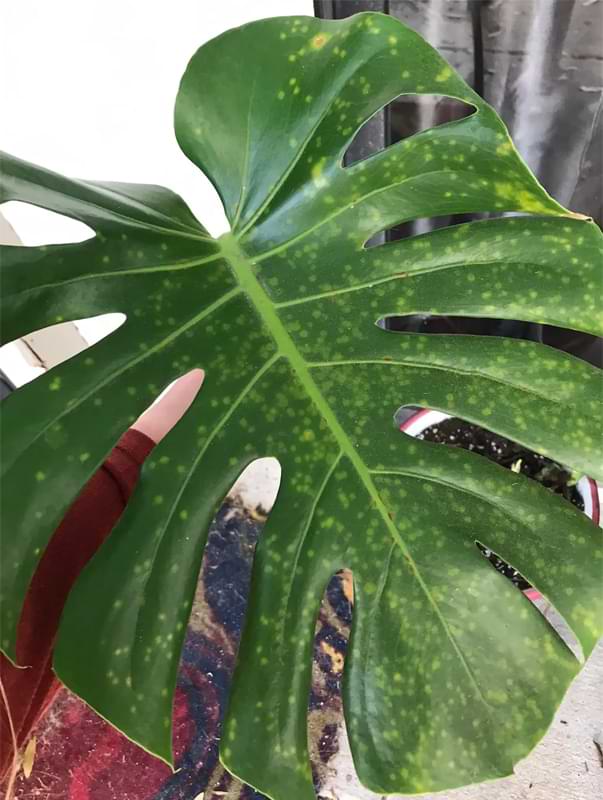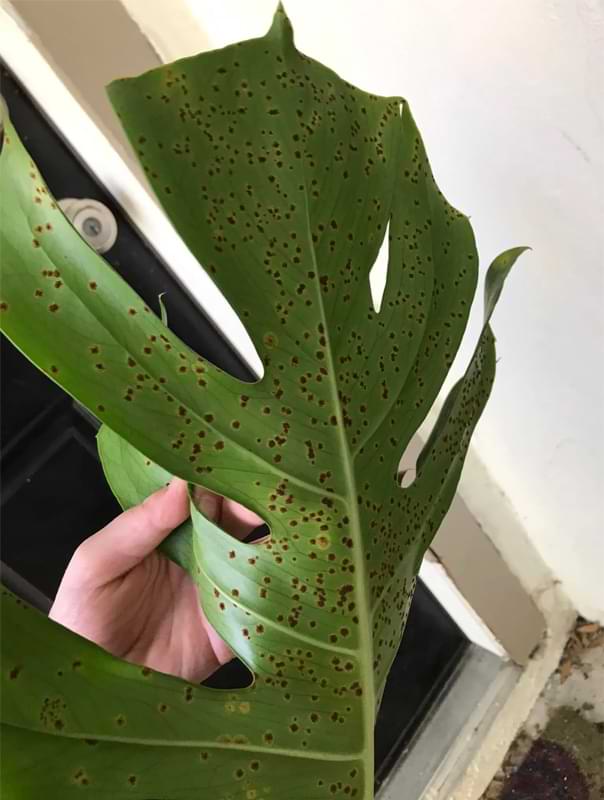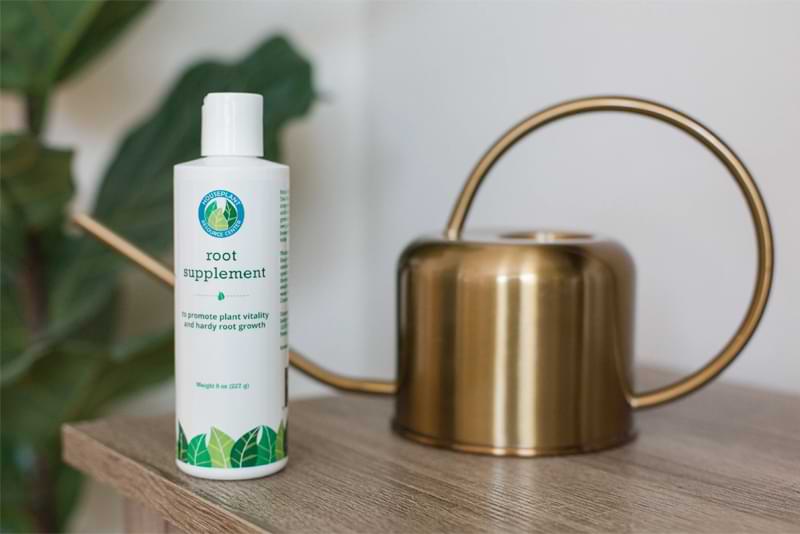Rust fungus on Monstera plants is a common problem for gardeners and plant lovers alike. This nasty fungus, caused by environmental stressors or other factors, can cause discoloration of leaves and halting of growth. But don’t worry—there are ways to combat rust fungus and keep your Monstera healthy!
There are six common causes of rust fungus on Monsteras and luckily, some fairly easy ways to combat it, along with ways you can fix it. We will also provide some tips for taking care of your Monstera so that rust fungus won’t be an issue in the first place. So read on to learn how to keep your Monstera looking its best!
Table of Contents
What Does Rust Fungus Look Like
If you think you see rust on your Monstera, take a close look. Rust fungus usually appears as small, orange-red spots on the leaves. The spots may be raised or sunken, and they may have a powdery texture. In severe cases, the spots can merge to form large patches of rust-colored fungus. The fungus can also spread to the stems of the plant, causing them to turn orange or red.
That being said, this fungus can also create red or black spots on the leaves. If the fungus has been left untreated, it may cover the entire leaf. It will usually first appear on the underside of the leaves, as this is where more moisture may accumulate. It can also first appear in areas of the plant that do not get as much air circulation, like where a leaf stem meets the main stem, or behind a larger leaf.
Signs and Symptoms
If you notice that your Monstera plant is starting to develop orange or brown spots on its leaves, it may be suffering from rust fungus. This is a common problem that can affect many different types of plants, but fortunately, it is relatively easy to treat.
Some of the most common symptoms of rust fungus include:
- Small, orange or brown spots on the leaves
- Leaves may become yellowed or discolored
- Plant may become stunted or sickly looking
- Flowers may fail to develop properly
If you think your Monstera plant has rust fungus, it is important to take action immediately. The sooner you treat the problem, the better chance your plant has of recovering.

6 Causes of Rust Fungus
Rust fungus is a common problem for indoor plants, and it can be especially troublesome for Monstera plants. There are a few different causes of rust fungus, and understanding these can help you treat the problem and prevent it from happening again.
1. Overwatering
Watering your Monstera is one of the most important aspects of plant care, but it’s also one of the easiest to get wrong. Overwatering is by far the most common reason for rust fungus on Monstera, and it’s a problem that can be difficult to fix.
If you think your Monstera has rust fungus, the first step is to check your watering habits. Are you watering too often? Is the soil constantly wet? These are signs that you’re overwatering your plant.
Rust fungus thrives in wet conditions, so the first step to fixing the problem is to let the soil dry out completely between waterings. This can be tricky, as you don’t want to under-water your plant and cause other problems. The best way to tell if the soil is dry is to use a moisture meter to monitor the soil moisture, but a much easier way to tell (although less accurate) is to stick your finger in it up to the first knuckle. If it feels dry, it’s time to water.
Once you’ve corrected your watering habits, you can start treating the rust fungus itself. There are a few different products on the market that will help kill rust fungi, but make sure to choose one that’s specifically labeled for use on Monstera plants. Follow the instructions on the package carefully, and be sure to treat all affected areas of the plant. Adding in a root supplement will help your Monstera fight off the infection, also.
With proper care, rust fungus on Monstera can be easily fixed. Just remember to check your watering habits and pay closer attention to your plant for the next couple of weeks while it recovers.
2. Insufficient Light
If your Monstera is infected with rust fungus, it could be because the plant isn’t getting enough light. If your Monstera is grown in an area that doesn’t receive much sunlight, it’s more susceptible to this disease.
To treat rust fungus that has taken advantage of your plants lack of natural light, move your Monstera to a brighter location and increase the amount of light it’s receiving. If possible, place the plant in direct sunlight for a few hours each day, as long as the sunlight isn’t too strong.
You may also need to decrease the frequency of watering, as rust fungus thrives in damp conditions. Keep the soil around your Monstera moist but not soggy, and be sure to remove any dead or dying leaves from the plant to prevent the spread of the disease.
3. Extreme Humidity
If you live in an area with high humidity, you’re probably no stranger to rust fungus. This pesky fungus thrives in warm, moist environments and can quickly turn your beautiful Monstera plant into a brown, wilted mess.
If you suspect high humidity to be the cause behind your plant’s rust fungus, consider placing a small fan in your plants area to circulate the air, or place a dehumidifier close to the plant. A good tool to use to monitor the humidity around your plant is a humidity meter.
4. Lack of Air Circulation
A lack of air circulation could be another reason your Monstera is growing rust fungus instead of new, beautiful leaves. This one is obviously easy to treat, but it may be hard to identify as the cause. If you’ve done everything else right when it comes to the care of your Monstera, and nothing else seems to be the problem, it very well could be a lack of air circulation.
This can be easily fixed by either placing a fan near your Monstera, or opening a window to allow the breeze to give it some fresh air on nice, temperate days.
5. Un-sanitized Tools
One of the most common causes of rust fungus on Monstera is unsanitized tools. If you’re using dirty or rusty tools to care for your plant, it’s more likely to develop problems like rust fungus. Make sure you’re using clean, sharp tools when you prune or repot your Monstera, and disinfect them between uses. You’ll know this is the cause of your plant’s rust fungus if your plant was otherwise healthy, and then began developing rust fungus after you’ve pruned it.
6. Transferred From Other Plants
If your Monstera has rust fungus, it could be that the fungus was transferred from another plant. Rust fungus can easily be transferred from one plant to another simply by two leaves brushing against each other, even for just a second.
The best way to prevent rust fungus is to keep your Monstera in a well-ventilated area with humidity only high enough to keep your Monstera happy. If you think that your plant may have been infected with rust fungus, it is important to quarantine the plant and remove any affected leaves. You can also treat the plant with a fungicide or bactericide.

Treatment
The good news is that there are some simple things you can do to treat rust fungus and keep it from coming back. One of the first steps to take is to quarantine your infected plant to prevent the fungus from spreading. After this, some basic care and maintenance will get your plant healthy and thriving again.
Quarantining Diseased Plants
As soon as you notice any possible rust fungus, take action as soon as possible. The first step is to quarantine the plant from your other houseplants. This will help prevent the spread of the disease.
Next, you’ll need to remove any leaves that have been affected by the fungus. Hopefully, it is isolated to one or two leaves, but a larger infestation may require a more aggressive treatment.
Removing Affected Leaves And Stems
Carefully inspect your entire plant for signs of rust fungus. Remember, they could be tiny little spots, or larger areas. With clean and sanitized pruning shears, cut off the leaves that have spots of rust fungus. If the fungus is on the stem, you will need to prune below the affected area. Don’t worry! As long as you have at least a few nodes left, your plant will continue to grow after it has recovered.
Pruning too much may send your plant into shock, so you may want to take this step slowly. If there are a lot of leaves or a lot of the stem to remove, try pruning a little bit every four to five days. This is a tricky game, though, because you’ll have to balance the spread of the fungus with your pruning schedule. You want to get all of the fungus off as quickly as possible without sending your plant into shock.
If the leaf only has one or two spots, you may be able to simply treat the spots with neem oil instead of pruning them off. That judgement call is up to you, though.
Treating With Neem Oil
After removing affected leaves and stems, you’ll want to treat your plant with neem oil. Neem oil is a natural, effective way to kill rust fungus. Simply mix 1 part neem oil with 2 parts water and spray onto your plant. Be sure to also spray the underside of the leaves, as that’s where the fungus often hides. Leave the mixture on for at least 6 hours, then rinse off with water. Repeat every few days until the rust fungus is gone.
Using Home Remedies To Treat Rust Fungus
While rust fungus may seem like a daunting problem, there are a few home remedies that can help treat and get rid of the fungus. One popular home remedy is to mix together equal parts baking soda and water to create a paste. This paste can then be applied directly to the affected areas of the plant.
Another option is to make a mixture of one part bleach to nine parts water and use this as a spray or soaking solution for the plant. Some people have used vinegar successfully to kill rust fungus, also. To try this method, mix one part vinegar to 5 parts water, and spray on each leaf. Leave it on until dry, and then wash it off.
Be sure to thoroughly rinse the plant after using either of these solutions, as long term exposure to these can cause even more damage to your beloved plant.
Using Fungicides
Fungicides are one of the most common treatments for rust fungus. They work by killing the fungi that cause the disease. There are many different types of fungicides available, so it is important to choose one that is specifically designed for rust fungus. Fungicides can be applied as a spray or a dust, and should be applied according to the manufacturer’s directions.
It is important to remember that fungicides only kill the fungi that cause rust fungus. They will not cure plants that are already infected. If possible, it is best to prevent rust fungus from occurring in the first place by providing good growing conditions for your plants.
Prevention
Prevention is always the best cure! To prevent rust fungus from attacking your Monstera, there are a few things you can do:
Choose Rust Resistant Plants
When selecting plants for your home, be sure to ask your nursery or garden center about their resistance to rust fungus and other diseases. Not many plants are naturally resistant to fungi, but it’s worth doing some additional research or asking local nurseries if they have any plants that are rust resistant. An easy way to boost your Monstera’s immunity to rust would be to keep it fertilized and give it a root supplement that will help it fight off any fungus or disease before it affects your plant.
Select Rust-free Plants When Purchasing
When it comes to rust fungus, prevention is key. That means selecting rust-free plants when purchasing, and being vigilant about checking your plants for early signs of infection.
If you’re buying plants from a nursery or garden center, inspect them carefully before making your purchase. Look for telltale orange or brown spots on the leaves, stem, or flowers. These are all signs that the plant may be infected with rust fungus.
If you see any suspicious spots, it’s best to err on the side of caution and choose a different plant. Once rust takes hold, it can be very difficult to get rid of. So it’s always better to start with a healthy plant that doesn’t have any sign of infection.
Issues Commonly Mistaken For Rust Fungus
There are a few things that can be easily mistaken for rust fungus on Monstera, as they share some similar symptoms. Here are some of the most common issues:
Powdery mildew: Powdery mildew is a type of fungi that appears as a white, powdery substance on the leaves of plants. It is often mistaken for rust fungus, as it can cause similar leaf discoloration and stunted growth. However, powdery mildew does not typically cause thick, rust-colored powdery residue or brown-orange spots on the leaves or stem.
Bacterial leaf spot: Bacterial leaf spot is another common plant disease that can be mistaken for rust fungus. Like rust fungus, bacterial leaf spot causes yellow or brown spots to form on the leaves of plants. However, bacterial leaf spot usually also causes dead patches or holes to form in the leaves.
Fertilizer burn: Fertilizer burn is a common problem for gardeners, especially when they are first starting out. Fertilizer burn appears as brown or yellow spots on the leaves of plants, and can sometimes be mistaken for rust fungus. However, fertilizer burn typically occurs around the edges of leaves, while rust fungus generally affects the whole leaf.
FAQ Rust Fungus On Monstera
What is the most effective treatment for killing rust fungus?
Many different fungicides are available to rid your plant of rust fungus. The fastest and easiest way to kill rust fungus is by using a fungicide specifically for rust fungus. This is typically a copper fungicide.
Will rust fungus harm pets or people?
This disease is not harmful to humans or animals. However, it can be unsightly and cause your plant to die if left untreated. If you have rust fungus on your Monstera plant, there are a few things you can do to try and fix it. That being said, it’s always a good idea to use proper protective equipment when treating your plant for rust fungus.
More Monstera Resources
Check out our other free resources to become a monstera plant care expert!






